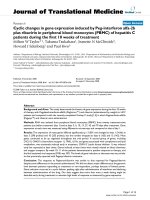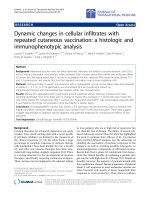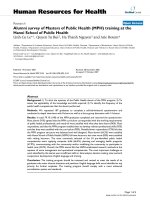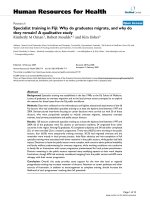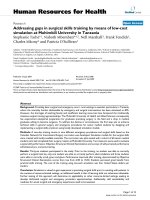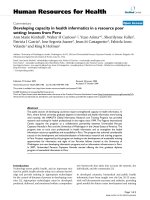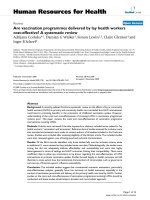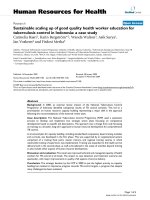báo cáo sinh học:" Recent changes in human resources for health and health facilities at the district level in Indonesia: evidence from 3 districts in Java" doc
Bạn đang xem bản rút gọn của tài liệu. Xem và tải ngay bản đầy đủ của tài liệu tại đây (234.27 KB, 6 trang )
RESEARCH Open Access
Recent changes in human resources for health
and health facilities at the district level in
Indonesia: evidence from 3 districts in Java
Peter Heywood
1*
, Nida P Harahap
2
, Siska Aryani
3
Abstract
Background: There is continuing discussion in Indonesia about the need for improved information on human
resources for health at the district level where programs are actually delive red. This is particularly the case after a
central government decision to offer doctors, nurses and midwives on contract the chance to convert to
permanent civil service status. Our objective here is to report changes between 2006 and 2008 in numbers and
employment status of health staff in three districts following the central government decision.
Methods: Information was derived from records at the district health office and, where necessary for clarification,
discussions with district officials.
Results: Across the three districts and all public sector provider categories there was an increase of almost 680
providers between 2006 and 2008 - more than 300 nurses, more than 300 midwives and 25 doctors. The increases
for permanent public servants were proportionately much greater (43%) than the total (16%). The increase in those
who are permanent civil servants was greatest for nurses (51%) and midwives (35%) with corresponding decreases
in the proportion of staff on contract. There was considerable variation between the three districts.
Conclusions: There has been a significant increase in the number of healthcare providers in the 3 districts
surveyed and the proportion now permanent public servants has increased even more than the increase in total
numbers. The changes have the effect of increasing the proportion of total public expenditure allocated to salaries
and reducing the flexibility of the districts in managing their own budgets. Because public servants are allowed
private practice outside office hours there has also been an increase in the number of private practice facilities
offering health care. These changes illustrate the need for a much improved human resources information system
and a coherent policy to guide actions on human resources for health at the national, provincial and district levels.
Background
We earlier reported on human resources for health [1]
and health facilities [2] at the district level in Indonesia
in 2006. For that report we enumerated healthcare pro-
viders (doctors, nurses and midwives) and health facil-
ities, both public and private, in 15 districts on Java.
In summary, for healthcare providers in 2006:
• Approximately half of all three professional groups
(doctors, nurses and midwives) were permanent civil
servants (PNS);
• Central government contracts (PTT) were of most
importance for midwives and were least important
for doctors;
• Local contracts
1
were most important for nurses
(41% across the 15 districts);
• The private sector as primary source of employ-
ment was most important for doctors (37% across
the 15 districts).
For facilities
2
:
• 86% of all facilities were solo-providers, and these
were all private; part-time private practice by nurses
was the largest group of solo-provider facilities,
* Correspondence:
1
Menzies Centre for Health Policy, University of Sydney, NSW, Australia
Full list of author information is available at the end of the article
Heywood et al. Human Resources for Health 2011, 9:5
/>© 2011 Heywood et al; licensee BioMed Central Ltd. This is an Open Access article distributed under the term s of the Crea tive
Commons Attribution License ( which permits unrestrict ed use, distribution, and
reproduction in any medium, provided the ori ginal work is properly cited.
despite the fact that private practice by nurses is
illegal;
• 13% of facilities were multiple providers giving
both inpatient and outpatient care; and
• 1% of facilities were multiple-provider giving both
inpatient and outpatient care - t hey are a mixture of
both public and private.
Our earlier report on personnel [1] also pointed out
that the civil service status of public sector employees
was set to change from that enumerated in 2006 as the
government had decided to offer those on contract
(including both central and local contracts) who met a
minimum set of criteria the opportunity to convert to
permanent civil service status (PNS - Pegawai Nasional
Sipil). At the same time a central government law pro-
hibited districts from hiring health staff on local con-
tracts or as volunteers [3,4] even though both of these
categories had been important in allowing districts some
flexibility in numbers and skills mix for their staff.
Further, there is an interaction between personnel pol-
icy and the situati on with health facilities. Because pub-
lic service doctors and midwives (both PNS and
contract) have the right to private practice an increase
in their number in a district is likely to result in
an increase in the number of private part-time solo-
provider facilities through which the public servant doc-
tors and midwives offer services after hours. The same
situation would apply with nurses as, although private
practice by nurses is not legal, it is widely acknowledged
that they do so as well. The increased numbers of health
staff may also stimulate an increase in the number of
multi-provider private facilities such as treatment clinics.
Our objective is to determine the extent and effect of
any increase in the number of civil service doctors,
nurses and midwives after the central government policy
change. In order to do so we re-censused these groups
and re-enumerated health facilities for the year 2008 in
three of the five districts we had earlier surveyed in
West Java Province (Ciamis District, Garut District,
Sukabumi District) in 2006. Here we report the results
and discuss the implications for policies for human
resources for health and development of the sector.
Methods
The work was carried out in mid-2009. The methods
were the same as used earlier and are described in detail
in [1] and [2]. The information was collected in each
district where the primary source of data was the district
health office and the district hospital. All health care
providers who do not work for the government but
have a private practice in which health care is provided
should be licensed by the government; our list was sup-
plemented by these sources as well. For each provider
we recorded their employ ment status and primary place
of work.
Results
Healthcare providers
The results are shown in Table 1. In summary, between
2006 and 2008 across the 3 districts:
• there was an increase of 680 staff in the health sec-
tor, more than 300 nurses, more than 300 midwives
and 25 doctors, an increase of 16%. There was con-
siderable variation between districts with the
increase being greatest in Garut District (347) and
least in Ciamis District (151).
• the increase in numbers was smallest for doctors
(6%) and greatest for midwives 24%;
The increases for permanent public servants (PNS)
were proportionately much greater than the total
• across all districts the number of PNS (doctors,
nurses and midwives) increased by 43%
• the increase was greatest for PNS nurses (51%)
(with considerable variation between districts from
32% in Garut to 97% in Sukabumi); in 2006 49% of
public sector nurses were PNS, the r emainder were
on local contracts as central contracts (PTT) have
never been available to nurses. By 2008, more t han
600 nurses, all on local contracts, had converted to
PNS. At the same time, an additional 300 nurses
were hired on local contracts so that the net change
in the number of nurses was an increase of 329
(Table 1).
• TheincreaseforPNSmidwiveswas35%overall
(with varia tion from 23% in Sukabumi t o 43% in
Garut ). In 2006, 67% of public sector midwives were
PNS, one-fifth were on central contracts and less
than one-sixth on local contracts. In 2008, almost
300 midwives, mostly on central contracts, were
converted to PNS. An additional 300 were hired on
contracts with the result that the net change in the
number of midwives was in increase of 326.
• the increase was least for PNS doctors, 27% overall
(with considerable variation between districts). In
2006, 63% of public sector doctors were PNS and
more than two-thirds of the remainder were on cen-
tral contracts. In 2008, 44 doctors, almost all on cen-
tral contracts, were converted to PNS. At the same
time the number of doctors in sole private practice
increased by 12. The result was an increase in the
number of doctors by 25.
• The increase across the 3 districts was greatest for
nurses and midwives - an average of more t han 100
per district for both midwives and nurses.
Heywood et al. Human Resources for Health 2011, 9:5
/>Page 2 of 6
Across doctors, nurses and midwives, the proportion of
PNS has increased from 53% in 2006 to 65% i n 2008 and
for contract staff has fallen from 39% to 28% over the
same period. The reduction in contract staff was particu-
larly marked for nurses who were all on local contracts.
Nevertheless, it is important to note that all districts are
sti ll hiring considerable numbers o f healthca re providers
on various forms of local contracts, despite the ban on
such hiring by the central government. In some cases the
law is ignored, in others it is circumvented merely by
using a different name for the local contract category.
The overall result is that the proportion of health staff
now PNS has increased and, as many of those converted
to PNS have been replaced by additional local contract
staff, the total number of health staff has increased.
There was a small increase in the number of health-
care staff in full-time private practice and the proportion
of the total remained virtually unchanged between 7%
and 8%.
Health facilities
The results are summarized in Tables 2, 3 and 4 for
Ciamis, Garut and Sukabumi Districts, respectively, and
across the three districts in Table 5. Given that doctors
and midwives have the right to private practice and
nurses also set up private practices even though they are
not allowed to do so under the regulations, the total
number of private practice facilities would be expected
to increase with any increase in the number of public
sector staff. This was i ndeed the case - an increase of
511 facilities overall, 369 of which were solo-provider
facilities and 142 multiple-provider facilities.
• For solo-provider facilities, more than half the
increases are the practices of nurses, most of the
remainder are village midwives.
• For multiple-provider facilities, the increase is basi-
cally shared between treatment centres and auxiliary
health centres.
Discussion
The decision by the government to convert contract staff
to PNS had three main effects. First, it increased the total
number of permanent civil servants in the health sector
in these three districts by 43% - as a result the proportion
Table 1 Healthcare staff in three districts of West Java Province by staff category and provider type, 2006 and 2008
(see Note 1 below)
Employment status General doctor Nurse Midwife All providers Percent
2006 2008 2006 2008 2006 2008 2006 2008 2006 2008
Ciamis District
Permanent public servant (PNS) 50 55 430 657 320 438 800 1150 57 74
Various forms of contract to public sector (see Note 2) 8 17 371 195 119 93 498 305 35 20
Private practice full-time 38 35 34 25 33 39 105 99 7 6
Total 96 107 835 877 472 570 1403 1554 100 100
Garut District
Permanent public servant (PNS) 59 66 573 758 277 397 909 1221 57 63
Various forms of contract to public sector (see Note 2) 33 27 411 429 173 176 617 632 39 33
Private practice full-time 53 68 0 0 18 23 71 91 4 5
Total 145 161 984 1187 468 596 1597 1944 100 100
Sukabumi District
Permanent public servant (PNS) 52 84 218 430 246 303 516 817 43 59
Various forms of contract to public sector (see Note 2) 55 21 350 221 123 170 528 412 44 30
Private practice full-time 99 99 20 21 37 33 156 153 13 11
Total 206 204 588 672 406 506 1200 1382 100 100
Three districts
Permanent public servant (PNS) 161 205 1221 1845 843 1138 2225 3188 53 65
Various forms of contract to public sector (see Note 2) 96 65 1132 845 415 439 1643 1349 39 28
Private practice full-time 190 202 54 46 88 95 332 343 8 7
Total 447 472 2407 2736 1346 1672 4200 4880 100 100
2008 minus 2006 25 329 326 680
Note 1: data for 2006 from Reference 1, Table 13a; data for 2008 from re-census in June 2009.
Note 2: ‘Various forms of contract’ includes central, district and facility contracts (PTT, kontrak), volunteers (sukwan) and daily hires (bidan harian lepas).
Heywood et al. Human Resources for Health 2011, 9:5
/>Page 3 of 6
of healthcare staff who are PNS increased from 53% to
65% while the proportion on contract decreased from
39% to 28%. Second, because the district governments
then hired additional staff on local contracts, the total
number of public sector heal thcare providers increased
by 16%. Third, there has been a significant increase in
the public sector salary costs, partly due to the increase
in total number of public sector staff (including the new
hires on local contracts to, at least partially, replace those
converted to PNS) and partly due to the increased com-
mitments of the government to the benefits, including
pensions, for the PNS staff.
There were considerable differences between the pro-
fessions - overall the n umber of PNS nurses increased
by 51%, midwives 35% and doctors 27%. T here are also
considerable differences between the districts.
These are very significant changes in the health sector
within the space of a year. The results presented here
Table 3 Facilities in Garut District, West Java Province,
2006 and 2008
Garut District 2006 2008
Public hospital (Rumah Sakit Umum Daerah (RSUD)) 1 1
Private hospital (Rumah Sakit Swasta (RSUS)) 1 1
Hospital for women and children (Rumah Sakit Ibu dan
Anak (RSIA))
00
Women’s hospital (Rumah Sakit Bersalin (RSB)) 0 0
Maternity clinic (Rumah Bersalin (RB)) 2 6
Health center (Pusat Kesehatan Masyarakat (Puskesmas)) 62 62
Auxiliary health center (Puskesmas pembantu (Pustu)) 132 135
Treatment clinic (Balai pengobatan (BP)) 8 69
Sub-total (multiple-provider facility) 206 274
Village midwife (Bidan di desa (BDD)/Pondok Bersalin
Desa (Polindes))
305 370
Doctor in full-time private practice 53 68
Doctor in part-time private practice 92 87
Nurse in part-time private practice 590 712
Midwife in full-time private practice 18 23
Sub-total (solo-provider facility) 1058 1260
Total 1264 1534
Table 4 Facilities in Sukabumi District, West Java
Province, 2006 and 2008
Sukabumi District 2006 2008
Public hospital (Rumah Sakit Umum Daerah (RSUD)) 3 3
Private hospital (Rumah Sakit Swasta (RSUS)) 2 2
Hospital for women and children (Rumah Sakit Ibu dan
Anak (RSIA))
00
Women’s hospital (Rumah Sakit Bersalin (RSB)) 0 0
Maternity clinic (Rumah Bersalin (RB)) 11 11
Health center (Pusat Kesehatan Masyarakat (Puskesmas)) 57 57
Auxiliary health center (Puskesmas pembantu (Pustu)) 98 110
Treatment clinic (Balai pengobatan (BP)) 47 53
Sub-total (multiple-provider facility) 218 236
Village midwife (Bidan di desa (BDD)/Pondok Bersalin
Desa (Polindes))
283 351
Doctor in full-time private practice 99 99
Doctor in part-time private practice 118 135
Nurse in part-time private practice 353 391
Midwife in full-time private practice 37 33
Sub-total (solo-provider facility) 890 1009
Total 1108 1245
Table 5 Facilities in three districts (Ciamis, Garut,
Sukabumi) combined, 2006 and 2008
Three district combined 2006 2008
Public hospital (Rumah Sakit Umum Daerah (RSUD)) 5 5
Private hospital (Rumah Sakit Swasta (RSUS)) 6 6
Hospital for women and children (Rumah Sakit Ibu dan
Anak (RSIA))
00
Women’s hospital (Rumah Sakit Bersalin (RSB)) 0 0
Maternity clinic (Rumah Bersalin (RB)) 15 19
Health center (Pusat Kesehatan Masyarakat (Puskesmas)) 170 170
Auxiliary health center (Puskesmas pembantu (Pustu)) 312 363
Treatment clinic (Balai pengobatan (BP)) 130 217
Sub-total (multiple-provider facility) 638 780
Village midwife (Bidan di desa (BDD)/Pondok Bersalin
Desa (Polindes))
861 996
Doctor in full-time private practice 190 206
Doctor in part-time private practice 268 281
Nurse in part-time private practice 1444 1614
Midwife in full-time private practice 207 242
Sub-total (solo-provider facility) 2970 3339
Total 3608 4119
Table 2 Facilities in Ciamis District, West Java Province,
2006 and 2008
Ciamis District 2006 2008
Public hospital (Rumah Sakit Umum Daerah (RSUD)) 1 1
Private hospital (Rumah Sakit Swasta (RSUS)) 3 3
Hospital for women and children (Rumah Sakit Ibu dan
Anak (RSIA))
00
Women’s hospital (Rumah Sakit Bersalin (RSB)) 0 0
Maternity clinic (Rumah Bersalin (RB)) 2 2
Health center (Pusat Kesehatan Masyarakat (Puskesmas)) 51 51
Auxiliary health center (Puskesmas pembantu (Pustu)) 82 118
Treatment clinic (Balai pengobatan (BP)) 75 95
Sub-total (multiple-provider facility) 214 270
Village midwife (Bidan di desa (BDD)/Pondok Bersalin
Desa (Polindes))
273 275
Doctor in full-time private practice 38 39
Doctor in part-time private practice 58 59
Nurse in part-time private practice 501 511
Midwife in full-time private practice 152 186
Sub-total (solo-provider facility) 1022 1070
Total 1236 1340
Heywood et al. Human Resources for Health 2011, 9:5
/>Page 4 of 6
for three districts, the outcome of a national policy, are
likely to be indicative of what happened across the
nation. They have important implications for the sector
as a whole in terms of funding, decentralization, health
facilities, sector performance, and the direction in which
the sector is heading.
Clearly any increase in the number of staff also
increases the salary bill, already running at 40% of all
public expenditure for health at the district level in these
districts [5]. Increasing the proportion of healthcare pro-
viders who are PNS has the effect of increasing the cost
of salaries and benefits (including their own health care)
for civil service staff, the item that, under Indonesia’s
decentralization, has first call on the general allocation
fund from the central government. Thus, in the absence
of a matching increase in the general allocation fund,
those available for operations expenses are decreased by
the extent to which salaries increase. Because the deci-
sion to increase the numbers of PNS and the use of cen-
tral transfers to meet the additional salary costs are made
by the central government, the funds over which the dis-
trict has discretion are also decreased, an action that con-
tinues the central claw back of control over funds
supposedly, under Indonesia’s decentralization [6], now
under the control of the district. At the same time, the
districts have replaced many of the staff converted to
PNS with additional staff on local contra cts. Even though
it was not possible to repeat the detailed assessment of
use of public funds made for 2006 [5], we know that an
increase in PNS numbers decreases the funds over which
the district has control. At the same time this central
decision relieves district authorities of the need to
increase productivity and rationalize their staffing pat-
terns and levels - why worry when the central govern-
ment will continue to pay. Districts h ad been creating
some flexibility in their hiring patterns through the use
of contract staff. Although it appears that flexibility is
now reduced as the central government has prohibited
districts from hiring contract staff, in reality it seems that
is not the case for despite this ‘ban’, districts are still hir-
ing staff on contract, apparently without incurring sanc-
tions from the central government. The overall effect is
that the public sector salary bill for the health sector has
increased.
The public portion of the Indonesian health system
has low levels of productivity [P Heywood, NP Harahap.
Hea lth centre product ivity in West Java Province, Indo-
nesia. Unpublished] and the performance of the sector
is inadequate [7]. In addition, the quality of care in
Indonesia is low [8-10]. Merely increasing the total
number of staff or the number who are permanent civil
servants without addressing the more systemic issues [7]
is unlikely to raise the quality or the overall perfor-
mance of the system.
Finally, this increase in the overall number of providers
in the system also results in an increase in the private
sector facilities - across the 3 di stricts, the 680 ad ditional
staff are associated with 511 additional facilities, 369
solo-provider facilities and 142 additional multi-provider
facilities. As is already the case, the quality of these addi-
tional services (public or private) is also likely to be lim-
ited and there is an urgent need for the public sector to
take its stewardship functions s eriously. Even so, the dis-
trict governments have few resources devoted to over-
sight of the quality of care. An increase in the PNS staff
alone without serious efforts to monitor service quality is
unlikely to lift the mediocre performance of the sector.
Whilst this increase in overall staff levels (and, indir-
ectly, facilities) and in the number and proportion of
permanent civil servants might be applauded as an
attempt to improve the low density of health service
providers in Indonesia [11] its effect on health system
performance is likely to be limited because it is not part
of an overall coherent approach to improving the per-
formance of the health sector [7]. At the same time the
health information system is unable to p rovide the dis-
trict level information needed to track changes and
understand human resources for health at the district
level. Because policy for human resources in health is
weak and civil service reform has stalled, the central,
provincial and district governments appear to be operat-
ing independently with respect to human resources in
health. For political reasons the central governme nt
decided to convert various forms of contract workers
(mostly PTT for doctors and midwives and only local
contract for nurses) to PNS. The West Java Provincial
governmenthasbeenusingitsownresourcestofund
extra doctors and other health staff through a provincial
contract scheme and BHL (a provincially-funded scheme
which is found only in West Java). The districts have
decided to maintain flexibility of hiring through the use
of ‘new’ categories of local contracts. Each level of gov-
ernment responds to a different constituency and inde-
pendentl y of the other. The human resources for healt h
policy is uncoordinated and weak. Further, there is no
overall health strategy which addresses the health pro-
blems of at least the next 30 years to provide a context
for the development of policy about its most important
asset, human resources. Indonesia needs both the strat-
egy and the policy as soon as possible.
Footnotes
1
Doctor, nurse or midwife who works for a health facil-
ity on a local government contract. Paid, hired and fired
bythedistrictgovernmentfromitsownbudget.Terms
and conditions of their employment are not well docu-
mented and there is variation between facilities and
districts.
Heywood et al. Human Resources for Health 2011, 9:5
/>Page 5 of 6
2
Health facility is defined as a physical structure
(which varies from a large complex of buildings to a sin-
gle room in a house) from which health services are
offered by a doctor, nurse or midwif e. See [2] for defini-
tions of each facility type.
Acknowledgements
The authors acknowledge the critical role played by staff of the district
health offices in the three districts.
The work was funded in part by a grant from the Ford Foundation.
Author details
1
Menzies Centre for Health Policy, University of Sydney, NSW, Australia.
2
Jalan Bukit Dago Selatan, Bandung, West Java Province, Indonesia.
3
Lecturer,
Politeknik Kesehatan, Bandung, West Java Province, Indonesia.
Authors’ contributions
PH and NPH conceived the study and drafted the manuscript. SA collected
the data and assisted with interpretation of the results. All authors reviewed
the final manuscript.
Competing interests
The authors declare that they have no competing interests.
Received: 26 March 2010 Accepted: 13 February 2011
Published: 13 February 2011
References
1. Heywood P, Harahap NP: Human resources for health at the district level
in Indonesia: the smoke and mirrors of decentralization. Human
Resources for Health 2009, 7:6 [ />content/7/1/6].
2. Heywood P, Harahap NP: Health facilities at the district level in Indonesia.
Aust NZ Health Policy 2009, 6:13.
3. Peraturan Pemerintah No. 48/2005. Pengangkatan tenaga honorer
menjadi calon Pegawai Negeri Sibil. 2005.
4. Peraturan Pemerintah 43/2007. Perubahan PP No. 48/2005.
Pengangkatan tenaga honorer menjadi calon Pegawai Negeri Sibil.
2007.
5. Heywood P, Harahap NP: Public funding at the district level in Indonesia
- sources, flows and contradictions. Health Research Policy and Systems
2009, 7:5 [ />6. World Bank: Decentralizing Indonesia: a regional public expenditure review -
overview report. Report No. 26191-IND Washington DC: World Bank; 2003.
7. Heywood P, Choi Y: Health system performance at the district level in
Indonesia after decentralization. BMC Int Health Hum Rights 2010, 10:3.
8. Barber SL, Gertler PJ, Harimurti P: The contribution of human resources
for health to the quality of care in Indonesia. Health Affairs 2007, 26:
w367-w379.
9. Barber SL, Gertler PJ, Harimurti P: Differences in access to high-quality
outpatient care in Indonesia. Health Affairs 2007, 26:w352-w366 [http://
content.healthaffairs.org/cgi/reprint/26/3/w352].
10. World Bank: Indonesia’s doctors, midwives and nurses: current stock,
increasing needs, future challenges and options. World Bank, Jakarta
Office; 2009.
11. WHO: Working together for health: The World Health Report 2006 Geneva:
World Health Organization; 2006.
doi:10.1186/1478-4491-9-5
Cite this article as: Heywood et al.: Recent changes in human resources
for health and health facilities at the district level in Indonesia:
evidence from 3 districts in Java. Human Resources for Health 2011 9:5.
Submit your next manuscript to BioMed Central
and take full advantage of:
• Convenient online submission
• Thorough peer review
• No space constraints or color figure charges
• Immediate publication on acceptance
• Inclusion in PubMed, CAS, Scopus and Google Scholar
• Research which is freely available for redistribution
Submit your manuscript at
www.biomedcentral.com/submit
Heywood et al. Human Resources for Health 2011, 9:5
/>Page 6 of 6
